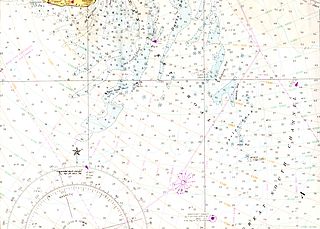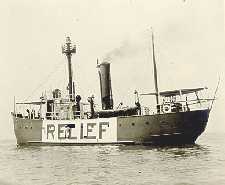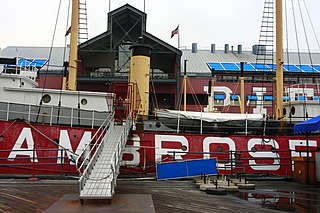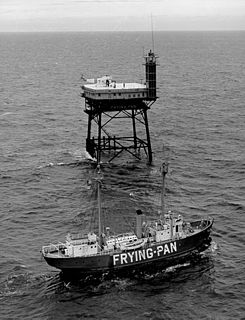Related Research Articles

A lightvessel, or lightship, is a ship that acts as a lighthouse. They are used in waters that are too deep or otherwise unsuitable for lighthouse construction. Although some records exist of fire beacons being placed on ships in Roman times, the first modern lightvessel was off the Nore sandbank at the mouth of the River Thames in England, placed there by its inventor Robert Hamblin in 1734. The type has become largely obsolete; lighthouses replaced some stations as the construction techniques for lighthouses advanced, while large, automated buoys replaced others.
The history of lightvessels in the United Kingdom goes back over 250 years. This page also gives a list of lightvessel stations within the United Kingdom, the Channel Islands and Gibraltar.

United States lightship Chesapeake (LV-116/WAL-538/WLV-538) is a museum ship owned by the National Park Service and on a 25-year loan to Baltimore City, and is operated by Historic Ships in Baltimore, Maryland. A National Historic Landmark, she is one of a small number of preserved lightships. Since 1820, several lightships have served at the Chesapeake lightship station and have been called Chesapeake. It was common for a lightship to be reassigned from one Lightship Station to another and thus "renamed" and identified by its new station name. Even though the "name" changed during a Lightship's service life, the hull number never changed. The United States Coast Guard assigned new hull numbers to all lightships still in service in April 1950. After that date, Light Ship / Light Vessel 116 was then known by the new Coast Guard Hull number: WAL-538. In January 1965 the Coast Guard further modified all lightship hull designations from WAL to WLV, so Chesapeake became WLV-538.

Northwest Seaport Maritime Heritage Center is a nonprofit organization in Seattle, Washington dedicated to the preservation and interpretation of Puget Sound and Northwest Coast maritime heritage, expressed through educational programs and experiences available to the public aboard its ships. The organization owns three large historic vessels docked at the Historic Ships' Wharf in Seattle's Lake Union Park; the tugboat Arthur Foss (1889), Lightship 83 Swiftsure (1904), and the halibut fishing schooner Tordenskjold (1911). These vessels are used as platforms for a variety of public programs, ranging from tours and festivals to restoration workshops and vocational training.

The station named Nantucket or Nantucket Shoals was served by a number of lightvessels that marked the hazardous Nantucket Shoals south of Nantucket Island. The vessels, given numbers as their "name," had the station name painted on their hulls when assigned to the station. Several ships have been assigned to the Nantucket Shoals lightship station and have been called Nantucket. It was common for a lightship to be reassigned and then have the new station name painted on the hull. The Nantucket station was a significant US lightship station for transatlantic voyages. Established in 1854, the station marked the limits of the dangerous Nantucket Shoals. She was the last lightship seen by vessels departing the United States, as well as the first beacon seen on approach. The position was 40 miles (64 km) southeast of Nantucket Island, the farthest lightship in North America, and experienced clockwise rotary tidal currents.

The United States lightship Huron (LV-103) is a lightvessel that was launched in 1920. She is now a museum ship moored in Pine Grove Park, Port Huron, St. Clair County, Michigan.

Sevenstones Lightship is a lightship moored off the Seven Stones Reef which is nearly 15 miles (24 km) to the west-north-west (WNW) of Land's End, Cornwall, and 7 miles (11 km) east-north-east (ENE) of the Isles of Scilly. The reef has been a navigational hazard to shipping for centuries with seventy-one named wrecks and an estimated two hundred shipwrecks overall, the most infamous being the oil tanker Torrey Canyon on 18 March 1967. The rocks are only exposed at half tide and it was not feasible to build a lighthouse so a lightvessel was provided by Trinity House. The first was moored near the reef on 20 August 1841 and exhibited its first light on 1 September 1841. She is permanently anchored in 40 fathoms (73 m) and is 2.5 miles (4.0 km) north-east (NE) of the reef. Since 1987, the Sevenstones Lightship has been automated and unmanned.

Light Vessel Number 83 (LV-83) Swiftsure is a lightship and museum ship owned by Northwest Seaport in Seattle, Washington. Launched in 1904 at Camden, New Jersey and in active service until 1960 after serving on all five of the American west coast's lightship stations, it is the oldest surviving lightship in the United States, the only one still fitted with its original steam engine, and the last lightship with wooden decks. LV-83 was designated a National Historic Landmark in 1989, and has been undergoing major restoration since 2008.

Lightship Ambrose was the name given to multiple lightships that served as the sentinel beacon marking Ambrose Channel, New York Harbor's main shipping channel.
The Seven Stones reef is a rocky reef nearly 15 miles (24 km) west-northwest (WNW) of Land's End, Cornwall and 7 miles (11 km) east-northeast (ENE) of the Isles of Scilly. The reef consists of two groups of rocks and is nearly 2 miles (3.2 km) long and 1 mile (1.6 km) in breadth. They rise out of deep water and are a navigational hazard for shipping with 71 named wrecks and an estimated 200 shipwrecks overall. The most infamous is the Torrey Canyon in 1967, which was at that time the world's costliest shipping disaster, and to date, still the worst oil spill on the coast of the United Kingdom.

United States lightship Nantucket (LV-112) is a National Historic Landmark lightship that served at the Lightship Nantucket position. She was the last serving lightship and at time of its application as a landmark, one of only two capable of moving under their own power. She served as the lightship for such notable vessels as the liners United States, Queen Mary, and Normandie.

Frying Pan (LV-115) is a lightvessel moored at Pier 66a in the Chelsea neighborhood of Manhattan in New York City. It served at Frying Pan Shoals, off Cape Fear in North Carolina, for over 30 years.

LV-117 was a lightvessel of the United States Lighthouse Service. Launched in 1931, she operated as the Nantucket lightship south of Nantucket Shoals. Moored south of Nantucket Island, Massachusetts, the lightship was at the western part of the transatlantic shipping lane and the first lightship encountered by westbound liners approaching New York Harbor. On May 15, 1934, one of these liners, RMS Olympic, rammed and sank LV-117, killing seven of her crew.

Lightship No. 114, later U.S. Coast Guard WAL 536, that served as lightship Fire Island (NY), Examination Vessel, Diamond Shoal (NC), 1st District relief vessel, Pollock Rip (MA) and Portland (ME). After decommissioning in 1971, in 1975 the lightship became a historic ship at the State Pier in New Bedford, Massachusetts. She received little maintenance, and eventually sank at her moorings in 2006 and was sold for scrap the next year.

The One Fathom Bank Lighthouse refers to two offshore lighthouses in the Strait of Malacca, specifically, on a shoal within Malaysian waters, dubbed One Fathom Bank, off the coast of the state of Selangor.

The United States lightship Barnegat (LV-79/WAL-506), is located in Camden, Camden County, New Jersey, United States. The lightship was built in 1904 and was added to the National Register of Historic Places on 29 November 1979.
USC&GS Drift was a United States Coast Survey schooner built in 1876 specifically to anchor in offshore waters to undertake current measurements. She was transferred to the United States Lighthouse Board on May 20, 1893 to become the lightship Light Vessel # 97 or (LV-97) on the Bush Bluff station until retirement and sale in 1918 to become the W. J. Townsend which was scrapped in 1945.
The Kentish Knock is a shoal in the North Sea, east of the Thames Estuary in southeast England.

The Bahama Bank Lightship was a Lightvessel stationed on the Bahama Bank east of Ramsey Bay, Isle of Man.
References
- 1 2 3 4 5 6 7 8 9 10 11 "Five Fathom Bank Lightship Station History". USCG Lightship Sailors Association International. Retrieved 7 August 2014.
- ↑ "Notice to Mariners". Boston Post (Boston, Massachusetts). 16 March 1891. p. 3. Retrieved 7 August 2014.
- ↑ "Cruiser New York". The Scranton Republican (Scranton, Pennsylvania). 27 March 1893. p. 1. Retrieved 7 August 2014.
- ↑ "The Minneapolis Fast". Fisherman and Farmer (Edenton, North Carolina). 22 June 1894. p. 1. Retrieved 7 August 2014.
- 1 2 3 "Ships Crash At Sea". The Washington Post (Washington, District of Columbia). 3 February 1913. p. 1. Retrieved 7 August 2014.
